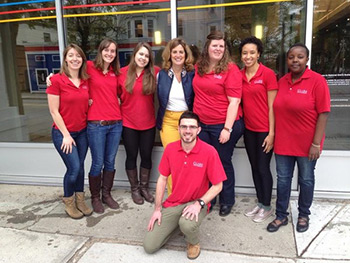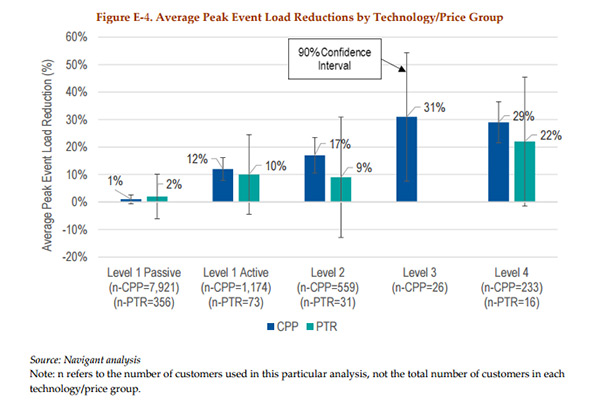By Samantha Caputo | Mon, October 24, 16
While completing my Masters of Science in Environmental Science and Policy at Clark University, I had the opportunity to work as a Smart Energy Ambassador at the National Grid Sustainability Hub (the Hub). Energy became my concentration in grad school; I look at it as the central point in environmental issues, as well as the solution. During my time at the Hub, I was able to interact with customers and help them engage with energy efficiency and demand response programs, while gaining a deeper understanding of how people use their energy. This experience got me more interested in energy efficiency programs and the customer experience.
The Sustainability Hub is located in Worcester, Massachusetts and serves as the community presence for National Grid’s Smart Energy Solutions Pilot Program. Fashioned like a home, the Hub engages customers in behavioral demand response by showing how energy efficient smart devices work with the smart meter, as well as how users can benefit from them.
Worcester was chosen for the Pilot because of the city’s diverse infrastructure with above and below ground wires, triple-deckers, single family homes, and multi-family homes. This allowed for insight into how energy is used from a variety of sources and how willing and/or able customers were to change their energy consumption patterns.
When I stepped away from my role at the Sustainability Hub and into my current position with NEEP, I realized the significance and importance of the Pilot in Worcester. I have been able to look at it from an outside perspective and gain a greater understanding as to why National Grid went about the Pilot in the way they did and what my role meant for the first year’s success.
National Grid succeeded in incorporating popular demand response approaches into the Pilot. This includes manual curtailment, or pricing signals, as well as direct load control through smart appliances and load control devices, and behavior demand response based upon residential customer engagement. National Grid offers customers in the Pilot the Smart Energy Solutions Pricing Plan. In addition, customers benefit from technology packages with a web portal, in-home displays, smart thermostats and load control devices.
The Hub

Having the Sustainability Hub helped attract people to the Pilot through marketing and education. As a Smart Energy Ambassador, one of my main roles was giving tours of the Hub, which included information about the Pilot and new advanced technologies. Creating a place where people can learn about home energy management systems (HEMS) and interact with new smart energy efficient technologies helps participants gain knowledge. Since the Hub dose not sell the technology, it makes it easier to talk technically about the appliances and sustainable building materials without the customer thinking you are trying to sell to them. In my experience at the Hub, I felt this created an open line of communication. Continuous communication and tips on how to save during the off-peak and peak seasons helps to normalize energy efficiency.
This was done in various ways, for instance we held a workshop on home energy savings during the holiday season and educated visitors about LED Christmas lights, baking in an oven with large window, and weatherizing the home. In addition, events, conferences, meetings, and presentations were held in the community room.
Whether the event was centered around the Hub or about a completely different topic, almost every time I worked an event, a conversation about what the Hub is occurred. People would ask, “Wait, what is this place? What is the Pilot program?” This engaged people who weren’t a part of the Pilot in the conversation and I enjoyed that aspect of my position at the Hub.
The Hub has also been great as a feedback mechanism for National Grid, because participants can talk to someone in person. Customers in the Pilot voiced concerns and gave testimonials on their personal experience in the Pilot program. There were also numerous times visitors would come in with billing questions, or just come in out of curiosity, which created additional opportunities to educate visitors about the Pilot and home energy savings.
Snapshot: 2015 Savings
During the spring semester, my final stretch to graduation, National Grid finished the first year of the Pilot. As an ambassador, I had to review National Grid’s Interim Evaluation Report and conceptualize the 2015 savings. A major part of the transition towards grid modernization and an energy efficient future is the integration of home energy management systems (HEMS). During the first year of the Pilot, customers with programmable communicating thermostats had the highest load reductions (29-31 percent were on critical peak pricing (CPP) and 22 percent on peak time rebate (PTR)). Customers with in-home displays followed with 17 percent on CPP and nine percent on PTR, trailed by customers with only Web Portal access (12 percent on CPP and 10 percent on PTR). The figure below shows the Peak Event load reductions by technology and price group. The takeaway from this is that if it is out of sight, then it is out of mind. The more in-home technologies a participant had to interact with, the higher their load reduction was, and therefore they saw greater savings on their bills.

At the Hub, we were able to simulate a Peak Event to show visitors what happens. The in-home displays relay a message, the green light on the thermostat turns red and the load control devices shut off technologies they are connected to. Customers who only had Web Portal access have to actively seek out information, whereas in-home displays filter through your energy usage and provide tips and notifications of peak events. Overall, the average per customer bill savings was $109 from January-September 2015 for customers on CPP. The average total rebates for customers on PTR was $20 for summer 2015 Conservation Day Peak Events.
In addition to HEMS, National Grid provides reports on energy usage to Pilot participants comparing their usage to other households similar to theirs. This approach of behavior demand response (BDR) is based on customer engagement. BDR is a software only approach to demand response. BDR uses the Advanced Meter Infrastructure (AMI) data to drive peak reduction at scale. Participants receive post-event feedback about individual demand savings to reinforce the value of participation.
When you can see your real-time energy usage and compare it to households similar to yourself, it brings out a sort of competiveness. Explaining this to participants at the Hub, I often found that people wanted to know how the program determined their house to be similar to a house nearby, and perhaps why another household is saving much more energy. Square footage, number of people, and so on; the more variables used to determine similar households, the better.
Lessons learned
One lesson learned during the first year of the Pilot is the need to prevent free ridership in the reward system. The rewards system changed for 2016 in order to create more customer engagement in energy savings. With the daily winner system in place in 2015, I received testimonials from customers across the spectrum. Some said they simply went out to dinner, or were out of the house that day and hadn’t really changed their behavior, but they “won.”
Others, particularly retirees who spend most time at home, were extremely engaged with the Pilot and took great measures to save energy. Through this rewards system, there wasn’t much differentiating between free ridership and active participants. The new system requires customers to interact online with the Worcester Smart Portal and earn points by actively taking measures to save energy, that add up to rewards. In turn, this should help eliminate free riders from earning rewards.
This new rewards system will prove beneficial because the Pilot is conducted on an out-out basis. This means everyone along the selected feeders was included. With opt-out, the participation levels will vary with active and passive participants. Through outreach and education about the online portal, the Pilot can attempt to transition passive participants to more active members. For instance, one way to earn points in the new rewards system is to visit the Hub, which is a great way to initiate the transition from a passive participant to an active one. On the other hand, an opt-in program will tend to attract people ahead of the curve who would all be active participants, but in fewer numbers. The opt-out program involves a wide diversity of customers.
Are you smarter than a fifth grader?
Another important takeaway from the Pilot is understanding the need for gradual introduction to customers and education about new concepts and technologies. Personally, I think this is one of the most exciting takeaways. We are truly in the midst of a revolutionary transition when adults are learning about the same concepts as children in elementary school and in Girl Scout/Boy Scout troops. Knowing that the younger generation is learning about energy efficiency, where electricity comes from, and what is means to be sustainable shows that this transition is here for the long run and that these changes are becoming a cultural norm.
Everyone, gather in the kitchen!

One of my favorite parts of the tour at the Sustainability Hub is the kitchen. I enjoy cooking and am always looking for ways to reduce my energy and water consumption. I really like that National Grid shows their dedication to not only energy efficiency, but also water, recycling and composting. The Hub is fashioned like a home to show visitors how to integrate the Pilot program into their home, as well as how they can live sustainably. I think the kitchen is a great place to start. The faucet is low flow, the dishwasher only uses 2.7 gallons of water and the oven has an oversized window for viewing your food. The range is an electric induction model, making it very responsive with very little waste heat. The oven also has hydrophilic coating, which makes cleaning much more efficient with only two cups of water and a shorter cleaning cycle. We wanted to show customers how these appliances worked, so we often had cookies baking in the oven and would check on them through the window, instead of opening the door. Small changes like this could result in major energy savings.
Looking ahead
The education I received from Clark University provided me with the tools to think critically about and understand the underlying concepts the Pilot program, but it was my experience at the Sustainability Hub that really helped shape the path I am on now and my interest in energy efficiency and sustainable consumption. My personal takeaway from the Pilot program is the importance of communicating with and educating society on the relevance of energy efficiency and the triple bottom line (people, planet, profit).
Energy efficiency can help businesses prosper, improve livelihoods, and reduce emissions from energy consumption. While working with NEEP, I have gained a fresh perspective into the Pilot, the Hub, and their contributions. Moving forward, I hope to gain more insight into the policies that shape these types of programs and help ensure their continued growth. I am eager to learn about the evaluation, measurement and verification process that goes into developing grid modernization programs, as well as dive into research about behavioral programs and demand response.
